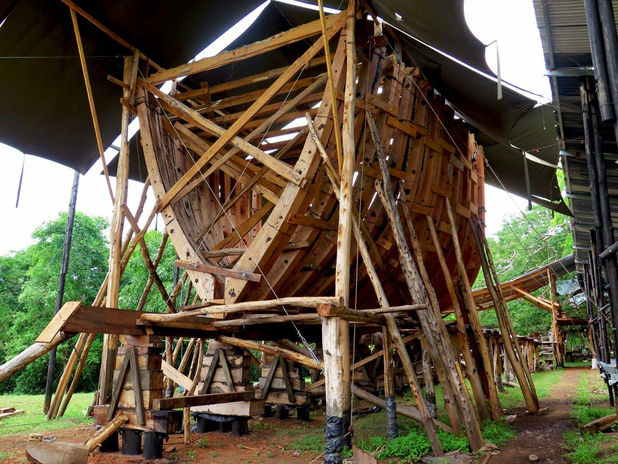
Astillero Verde
The worldsFirst Regenerative shipyard

"A living example of circular economy, ecological restoration, and community empowerment in Punta Morales, Costa Rica."
Before building a tallship, Sailcargo first needed a shipyard. when we began to rent the land in punta morales, we immediately began to create a shipyard by building the 'semi-temporary' infrastructure that was needed to build Ceiba.
In the tropical mangroves of central america... where crocodiles roam free and wide and the mosquitos are rampant; where the sun burns hot and the torrential rains quickly turn earth to mud we built the first workshops and treehouses,
The Vision
Astillero Verde was founded to prove that sustainable shipbuilding can coexist with ecological regeneration and community resilience. The initiative grew out of a bold vision by SAILCARGO INC.—to build zero-emission cargo vessels while restoring the land and creating long-term value for the local community.
The shipyard was imagined not just as a place of production, but as a regenerative ecosystem. —integrating reforestation, education, waste reuse, and localized food and energy systems.
The Process
1. Site Development & Permaculture Integration:
The site was designed as a regenerative hub, blending a working shipyard with native forest restoration and food-producing gardens.
2. Reforestation: TreesForSeas Program:
Over 10,000 native trees have been planted in the Bellbird Biological Corridor, aiming to sequester carbon and support biodiversity, as well as provide future generation with shipbuilding lumber.
3. Community-Based Learning:
The Camarita Regenerative Center was established to host educational programming focused on agroforestry, permaculture, and regenerative design.
4. Material Circularity & Waste Innovation:
Shipbuilding byproducts are repurposed on-site, minimizing waste and maximizing reuse—aligned with a closed-loop, zero-waste philosophy.
5. Economic and Social Regeneration:
Employment opportunities are created for locals, and skills-sharing workshops help build a culture of sustainability and stewardship.
The Outcome
Astillero Verde has become an internationally recognized model of regenerative design in action. The reforested land supports local flora and fauna while offsetting emissions from traditional industrial practices. Local families are gaining tools for food sovereignty and sustainable livelihoods, while global audiences are inspired by the integration of slow industry with ecological healing.
Materials & Sustainability Notes
* Native tree species selected for reforestation
* Renewable and salvaged building materials
* On-site composting and greywater systems
* Natural building methods (e.g., earthen materials)
* Educational programming grounded in real-world practice
Reflection
Astillero Verde challenges the false dichotomy between industry and ecology. By redefining what a shipyard can be, this initiative shows how *working with nature*—instead of against it—is not only possible, but necessary.
It’s not just about building ships—it’s about building futures rooted in regeneration, resilience, and respect.
Shipyard infrastructure and overall layout
Casa Almendra
Casalmendra was built entirely out of shipbuilding offcuts, and plantation teak posts and branches harvested from the nearby Camarita Regenerative Center.
The building was designed as comfortable crew accomodation (upper floor) and functional workshop below. adapted to life in the mangroves, the buildings design has ecceptional airflow, plenty of shaded area with trees growing in and throughout the building. the greywater is captured for the biochar project, and the building was designed and built around the trees that were currently onsite.






SAILCARGO INC.
As co-founder, board member and creative/ technical director of Sailcargo, Lynx and his team are developing new standards in the world of ecological cargo shipping.
SAILCARGO INC. is a pioneering company based in Costa Rica, dedicated to transforming the maritime shipping industry through sustainable and regenerative practices. The company is constructing Ceiba, a 45-meter wooden topsail schooner designed to operate without fossil fuels, utilizing wind power and an auxiliary electric engine. This vessel aims to be the world's largest active, emission-free cargo ship upon completion.
Integral to SAILCARGO INC.'s mission is Lynx Guimond, the company's Technical Director. A seasoned carpenter, shipwright, and designer, Guimond brings a wealth of experience from various construction disciplines. His notable works include figureheads for Dutch tall ships and bio-constructions in Costa Rica's wilderness. At SAILCARGO INC., he leads the construction of Ceiba and the development of the AstilleroVerde shipyard, emphasizing sustainable and ethical shipbuilding practices.
Guimond's approach integrates traditional craftsmanship with innovative, regenerative systems, aiming to set new standards in the maritime industry. His leadership reflects a commitment to environmental protection, social responsibility, and financial sustainability, aligning with SAILCARGO INC.'s triple bottom line philosophy.























